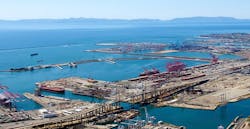Anchors Away for Microgrids: National Lab Publishes Port Electrification Guide
The shipping industry worldwide is a huge emitter of air pollution, accounting for close to 3% of greenhouse gas emissions globally.
At the same time, many ports are working to reverse those environmental impacts with moves to electrification and microgrids. In the U.S., ports at Los Angeles, Long Beach, Galveston, Oakland, San Diego, Bellingham, Wash., and Cleveland, among others, are stepping into the energy transition with projects ranging from electrifying fleets to warehouse equipment.
So much is going on port-side that the Pacific Northwest National Lab (PNNL) and its operator, Battelle, published a new “Port Electrification Handbook: A Reference to Aid U.S. Port Energy Transitions”. PNNL and Battelle prepared the guide under contract for the U.S. Department of Energy.
Among the contributors to the handbook include some of the ports noted above, as well as the Georgia Ports Authority, the Ports of Alaska, Seattle and Detroit, Sandia National Laboratories and the Northwest Seaport Alliance, among others.
“Port electrification can take many forms, such as electrifying cargo handling equipment or deploying a microgrid to power critical port infrastructure,” reads the executive summary to the PNNL Port Electrification Handbook. “The goals of this handbook are the following: Help port operators and planners evaluate different electrification technologies; explain how these technologies could aid and impact ports and surrounding communities; provide step-by-step considerations for port electrification.”
More than 2 billion short tons of cargo pass through U.S. ports every year, even during the supply chain constraints of the COVID pandemic. Those containers comprise close to 40% of global freight value, according to the U.S. Department of Transportation.
These volumes make decarbonization both a challenge and a priority, energy transition experts say. The benefits of port and fleet electrification include improved air and water quality, noise reduction, long-term cost savings, critical infrastructure resiliency and energy independence, according to the PNNL handbook.
The challenges are equipment availability, upfront costs, utility coordination, labor impacts and electrical supply, the document noted. For many ports seriously undertaking electrification, the planners are increasingly turning to on-site microgrids to offset electricity resource and delivery constraints at the power utility level.
Earlier this week, logistics firm Prologis and its Maersk-owned partner, Performance Team, launched a heavy-duty charging depot near the Ports of Los Angeles and Long Beach, which are among the nation’s busiest cargo transport facilities. The charging depot is powered by a large microgrid that includes 2.75 MW of fuel-flexible linear generators and 18 MWh of battery storage capacity.
The Port of Long Beach is busy on several electrification fronts inside the facility grounds. Toyota's vehicle processing facility is now completely powered by on-site renewable energy, including a biogas-to-hydrogen production system.
Schneider Electric is working with the same port to complete a $12.2 million microgrid project.
Microgrids are necessary to port electrification projects for multiple reasons, the PNNL handbook pointed out.
“Intermittent disruptions from the bulk power system can interrupt the power supply to the electrified port, resulting in an impact to port operations,” the document reads. “Microgrids not only enable a backup source of power for critical facilities, but they can also be used to keep operations running during shorter outages or enable a limited set for disaster recovery.”
The Port Electrification Handbook acknowledges that upfront investment costs for microgrids and other equipment can be expensive. Long-term, however, electrification can result in significant cost savings as electric equipment is often more energy efficient and can reduce operational costs over the long haul.
Track Port Electrification and Microgrids by Reading our Free MGK Newsletter
About the Author
Rod Walton, Microgrid Knowledge Managing Editor
Managing Editor
For Microgrid Knowledge editorial inquiries, please contact Managing Editor Rod Walton at [email protected].
I’ve spent the last 15 years covering the energy industry as a newspaper and trade journalist. I was an energy writer and business editor at the Tulsa World before moving to business-to-business media at PennWell Publishing, which later became Clarion Events, where I covered the electric power industry. I joined Endeavor Business Media in November 2021 to help launch EnergyTech, one of the company’s newest media brands. I joined Microgrid Knowledge in July 2023.
I earned my Bachelors degree in journalism from the University of Oklahoma. My career stops include the Moore American, Bartlesville Examiner-Enterprise, Wagoner Tribune and Tulsa World, all in Oklahoma . I have been married to Laura for the past 33-plus years and we have four children and one adorable granddaughter. We want the energy transition to make their lives better in the future.
Microgrid Knowledge and EnergyTech are focused on the mission critical and large-scale energy users and their sustainability and resiliency goals. These include the commercial and industrial sectors, as well as the military, universities, data centers and microgrids. The C&I sectors together account for close to 30 percent of greenhouse gas emissions in the U.S.
Many large-scale energy users such as Fortune 500 companies, and mission-critical users such as military bases, universities, healthcare facilities, public safety and data centers, shifting their energy priorities to reach net-zero carbon goals within the coming decades. These include plans for renewable energy power purchase agreements, but also on-site resiliency projects such as microgrids, combined heat and power, rooftop solar, energy storage, digitalization and building efficiency upgrades.


